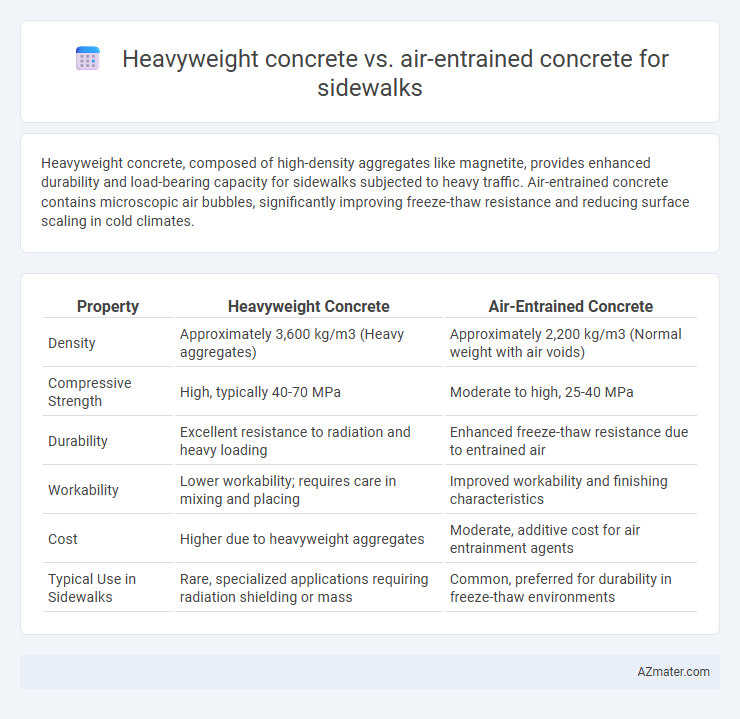Heavyweight concrete, composed of high-density aggregates like magnetite, provides enhanced durability and load-bearing capacity for sidewalks subjected to heavy traffic. Air-entrained concrete contains microscopic air bubbles, significantly improving freeze-thaw resistance and reducing surface scaling in cold climates.
Table of Comparison
| Property | Heavyweight Concrete | Air-Entrained Concrete |
|---|---|---|
| Density | Approximately 3,600 kg/m3 (Heavy aggregates) | Approximately 2,200 kg/m3 (Normal weight with air voids) |
| Compressive Strength | High, typically 40-70 MPa | Moderate to high, 25-40 MPa |
| Durability | Excellent resistance to radiation and heavy loading | Enhanced freeze-thaw resistance due to entrained air |
| Workability | Lower workability; requires care in mixing and placing | Improved workability and finishing characteristics |
| Cost | Higher due to heavyweight aggregates | Moderate, additive cost for air entrainment agents |
| Typical Use in Sidewalks | Rare, specialized applications requiring radiation shielding or mass | Common, preferred for durability in freeze-thaw environments |
Introduction to Concrete Types for Sidewalks
Heavyweight concrete, characterized by its dense aggregate composition such as barite or magnetite, offers exceptional durability and resistance to impact, making it suitable for heavy-load sidewalks and industrial applications. Air-entrained concrete incorporates microscopic air bubbles that improve freeze-thaw resistance and reduce surface scaling, ideal for sidewalks exposed to harsh weather conditions and deicing salts. Choosing between heavyweight and air-entrained concrete depends on factors like load requirements, environmental exposure, and long-term durability needs for sidewalk projects.
Overview of Heavyweight Concrete
Heavyweight concrete is specifically designed with high-density aggregates such as hematite or magnetite, resulting in a significantly higher unit weight compared to conventional concrete, making it ideal for applications requiring enhanced radiation shielding or structural mass. This type of concrete provides superior durability and strength, which can benefit sidewalks in high-traffic or heavy-load areas by improving wear resistance and longevity. In contrast to air-entrained concrete, heavyweight concrete offers less freeze-thaw resistance but excels in providing mass and density, essential for specialized construction needs.
Overview of Air-Entrained Concrete
Air-entrained concrete incorporates microscopic air bubbles created by air-entraining agents, enhancing its resistance to freeze-thaw cycles and reducing surface scaling, which makes it ideal for sidewalks exposed to harsh weather conditions. This type of concrete improves durability and prevents cracking by accommodating moisture expansion during freezing, ensuring a longer lifespan for pedestrian pathways. Compared to heavyweight concrete, air-entrained concrete offers superior freeze-thaw durability while maintaining sufficient strength for typical sidewalk load demands.
Key Material Properties Comparison
Heavyweight concrete features high density due to aggregates like barite or magnetite, enhancing radiation shielding and structural weight, while air-entrained concrete incorporates microscopic air bubbles that improve freeze-thaw durability and resistance to scaling. The compressive strength of heavyweight concrete typically ranges from 24 to 40 MPa, whereas air-entrained concrete maintains similar strength but with superior resistance to environmental damage. In terms of thermal properties, heavyweight concrete has higher thermal conductivity due to denser materials, contrasting with the insulating effect created by entrained air in air-entrained concrete, making each suitable for different sidewalk performance requirements.
Durability and Performance in Sidewalk Applications
Heavyweight concrete offers superior durability for sidewalks due to its high-density aggregates, enhancing resistance to impact and heavy loads, which reduces wear over time. Air-entrained concrete improves freeze-thaw resistance by incorporating tiny, stable air bubbles that prevent internal cracking, making it ideal for sidewalks exposed to harsh weather conditions. Selecting between heavyweight and air-entrained concrete depends on the specific environmental and load requirements of the sidewalk application, optimizing performance and longevity.
Resistance to Freeze-Thaw Cycles
Heavyweight concrete, due to its dense aggregate composition, offers enhanced mass but typically demonstrates lower resistance to freeze-thaw cycles compared to air-entrained concrete. Air-entrained concrete contains microscopic air bubbles designed to absorb internal pressure during freezing, significantly improving durability in cold climates for sidewalks. This air entrainment reduces surface scaling and internal cracking, making it the preferred choice for freeze-thaw exposure in pedestrian walkways.
Environmental and Weather Adaptability
Heavyweight concrete offers superior durability and radiation shielding but tends to have a higher carbon footprint due to dense aggregates like magnetite or barite, making it less environmentally sustainable for sidewalks. Air-entrained concrete improves freeze-thaw resistance by incorporating microscopic air bubbles, enhancing weather adaptability and extending sidewalk lifespan in cold climates with frequent temperature fluctuations. Selecting air-entrained concrete reduces maintenance needs and environmental impact while providing better performance in harsh weather conditions compared to heavyweight concrete.
Cost and Installation Considerations
Heavyweight concrete, composed of dense aggregates like barite or magnetite, typically incurs higher material and transportation costs compared to air-entrained concrete, which uses standard aggregates with added air-void systems to improve freeze-thaw durability. Installation of heavyweight concrete requires specialized handling due to increased weight, affecting labor and equipment needs, while air-entrained concrete facilitates easier placement and finishing processes in sidewalk construction. Cost efficiency favors air-entrained concrete for most sidewalk projects, whereas heavyweight concrete is selected primarily for applications requiring enhanced radiation shielding or mass.
Maintenance Requirements and Longevity
Heavyweight concrete, composed of dense aggregates such as magnetite or barite, offers superior durability and resistance to wear, reducing maintenance frequency for sidewalks exposed to heavy traffic or harsh environmental conditions. Air-entrained concrete contains microscopic air bubbles that improve freeze-thaw resistance, preventing cracking and surface scaling in colder climates, therefore extending sidewalk longevity. While heavyweight concrete excels in load-bearing and abrasion resistance, air-entrained concrete provides better frost durability, making maintenance needs and lifespan dependent on local climate and usage intensity.
Best Use Cases: Choosing the Right Concrete for Your Sidewalk
Heavyweight concrete is ideal for sidewalks in high-traffic industrial areas where enhanced density and radiation shielding are required, offering superior durability and strength. Air-entrained concrete excels in cold climates by providing resistance to freeze-thaw cycles through its microscopic air bubbles, reducing surface scaling and cracking. Selecting the right concrete depends on environmental exposure and load requirements, with heavyweight concrete supporting heavy loads and air-entrained concrete ensuring longevity in freeze-prone regions.

Infographic: Heavyweight concrete vs Air-entrained concrete for Sidewalk
 azmater.com
azmater.com